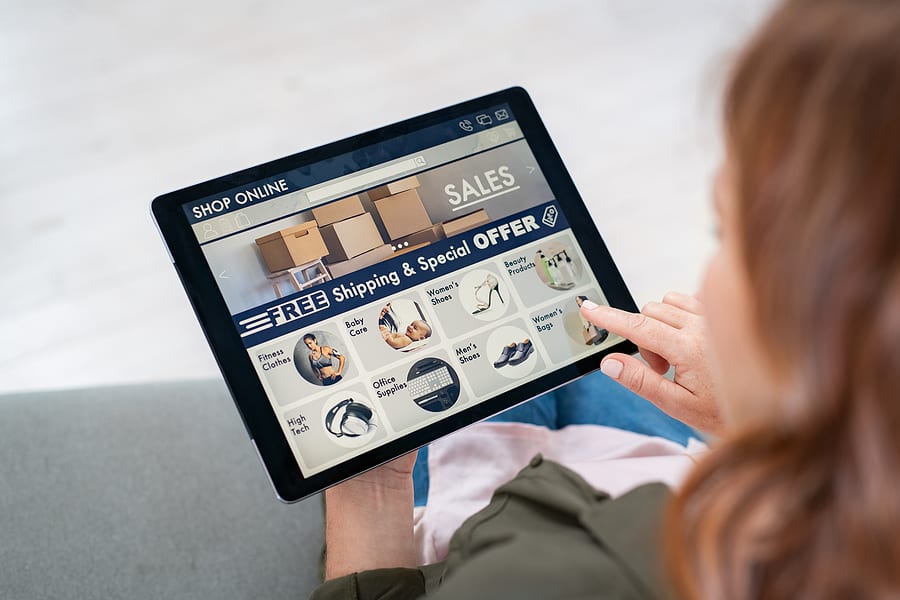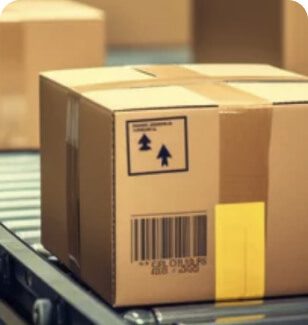These Labor Day Ecommerce Statistics Paint the Holiday Shopping Picture

Now, the holiday is best known as the unofficial end of summer and is celebrated with a long weekend full of barbeques and soaking up the sun. It’s also a major shopping event that continues the momentum of back-to-school season and carries retailers swiftly into the holiday shopping rush.
Though Labor Day is going to look different this year, consumers are still going shopping. They’re just doing it online. These Labor Day ecommerce statistics paint the holiday shopping picture for e-tailers, and we also have some tips to get your store prepared.
Read on to learn more.
2020 Ecommerce Sales Are Up 77.8%
Shelter-in-place orders and mandated store closures affected nearly everyone across the country earlier this year. In response, many turned to ecommerce for their consumer needs. The Adobe Digital Economy Index report for May 2020 reveals that ecommerce spending has surpassed expectations for this point in the year by a whopping $52 billion.
The main reason? More than $82.5 billion was spent online in May alone, which is a 77.8% year-over-year increase. The figure also eclipses total spending from the 2019 holiday shopping season.
What’s more, Adobe analysts believe the shift to ecommerce is a permanent one. Consumers had to get familiar with shopping online during the first three months of the pandemic, and they formed habits that would influence their future spending. It’s a major win for e-tailers.
The BOPUS (buy online, pick up in store) trend is largely impacting this shift, and there’s no wonder why. BOPUS is the best of both worlds: the convenience of shopping online with the instant gratification of buying in store. There are no shipping fees, either. The service also gave consumers access to the in-store inventory that was off limits during the height of stay-at-home orders.

Most shoppers agree that offering click-and-collect is a necessary commodity and “very valuable” to the shopping experience. Business Insider reports that 70% of shoppers are using BOPUS at any given time, and 62% of Americans have used it multiple times within the past year.
How does this impact your Labor Day plans? Well, the writing is on the wall. E-tailers can expect to be busy. Consumers have already spent far more than anticipated this year, and they’re fully willing to open their wallets for more online shopping, especially if there are deals to be found.
Nearly 90% Plan to Shop for Deals
Nearly every holiday is a shopping holiday in the 21st century, and it’s a setup that benefits both retailers and consumers. Retailers get several chances to take advantage of the time their customers have away from work, and consumers get access to limited-time promotional events. It’s a win-win.
Labor Day is no different. Last year, 86% of consumers reported that they were ready to look for deals, and 76% of those who planned to shop were going to do it online. The percentage of shoppers turning to ecommerce will likely be higher this year, so e-tailers can look forward to a lucrative Labor Day. As we noted previously, consumers are no less enthusiastic to buy things in 2020 as they were in previous years.
Shoppers Spend Billions
2018 was a record-breaking year for Labor Day shopping. American consumers collectively spent a jaw-dropping $2.08 billion in one day, up from $1.69 billion the Labor Day before. The sales growth even surpassed what was seen on both Memorial Day and Independence Day. It was a huge win for retailers and boosted their confidence ahead of the holiday shopping season.
How will this spending break down? According to a TopCashBack.com survey, 45% of shoppers plan to spend anywhere from $101 to $500, and 33% are budgeting between $51 and $100. The remaining respondents were unwilling to spend more than $50 on Labor Day shopping. This averages out to $150 per shopper, which adds up quickly and bodes well for your online store.
Email Matters
We’ve always said that email marketing is a powerful tool, but data from Adobe Digital Insights can back us up. Per their findings, email drives the most (30% of) Labor Day sales—more than direct traffic, search or social media. This is because email is a direct line to your customers and prospects, and messages can be fully optimized with a number of strategies.
Segmentation, for example, delivers different emails to each group, or segment, based on what the recipients have in common. It adds a touch of personalization by crafting email messaging to broadly appeal to the readers. Age, location and purchasing frequency are all examples of segmentation ideas. Emails can also be personalized with the reader’s name or with product recommendations based on past purchases.
The goal of email marketing is to build relationships with your customers and connect with them. If you make them feel seen and understood, they will keep coming back to shop at your online store because they appreciate the recognition.
Take a look at these ecommerce email marketing statistics so you can be the superhero of your marketing team:
- Emails with personalized subject lines are 22% more likely to be opened.
- Subject lines contribute to 64% of email opens.
- 82% of consumers are willing to open emails from brands they’re familiar with.
- Email marketing spend only increases by 10% year-over-year, far less than necessary spend for other tactics.
- Return on investment can reach 3,800%.
- 60% of marketers agree that email is more effective than social media.
Electronics & School Supplies Top the List
In a survey of American consumers, the top three most popular categories for Labor Day shopping were school supplies (28%), clothes (22%) and electronics (18%). This makes sense for many reasons.
- School supplies have historically always been a hallmark of Labor Day shopping because the holiday coincides with the start of the school year. Though supply lists are often distributed during the summer, many parents will hold off until Labor Day sales begin so they can get a better deal on their children’s supplies.
- Clothes are also a large part of back-to-school shopping. For students who don’t wear uniforms to school, Labor Day is the chance to stock up on the latest styles at the best prices.
- Electronics, it seems, is the odd one out. There are certainly consumers who purchase items like laptops and tablets for the start of the school year, but that’s not why electronics are in the top three categories. TVs, game consoles and other consumer electronics are big ticket items, so even small discounts mean huge savings. Consumers typically conduct product research ahead of time and then strike while the iron is hot.
How to Prepare for the Labor Day 2020 Rush
Now that you’re armed with the latest Labor Day ecommerce statistics, you know the long weekend is a huge opportunity to kick off the holiday shopping season with a strong performance from your online store. Here are some tips to make the most of Labor Day 2020.
Start Preparing Now
The biggest names in retail start their holiday preparations for the following year as soon as one year’s event has passed. That kind of dedication isn’t entirely necessary for smaller sellers and less important shopping holidays like Labor Day, but the key is to prepare early.
Test your site speed, optimize your checkout and follow our tips to increase conversions. You might also want to consider launching your Labor Day sales slightly early to get potential customers’ attention. Ecommerce has only gotten more competitive this year, so you need every advantage possible over your competitors.
Highlight Apparel
Even if your online store isn’t clothing-focused, now is the time to highlight any apparel items in your catalog. Labor Day falls at the tail end of the back-to-school shopping season, so many retailers looking to maintain their momentum will discount clothing.
Apparel is a popular category among Labor Day shoppers, per the latest studies. By the time the long weekend rolls around, consumers will still be looking for great deals on clothing. This could be your opportunity to win over new customers.
Optimize for Mobile
Cell phones aren’t just for calling and texting on the go, so why do some e-tailers still have mobile-unfriendly websites?
Statista research finds there are 3.5 billion smartphone users globally, and they spend nearly four hours using those phones per day. Of those connected to the Internet, two-thirds are using shopping apps. These statistics tell an important story: there’s a lot of opportunity in mobile shopping.
If you’ve been putting off optimizing your website for mobile users, you’re already way behind. There is good news, however. It’s not too late to get your website ready for mobile Labor Day shoppers. Keep these tips in mind for maximum effect.
- Simplify the site. The smaller screens of mobile devices allow for less webpage clutter, so take the minimalist approach. Focus on navigation rather than design.
- Get more clicks. All clickable elements on your mobile site should be large and intuitive so there is no confusion for shoppers.
- Optimize all forms. If you’re capturing customer (or prospective customer) information, the fields should be clearly labeled and easy to zoom in on.
- Streamline your mobile pipeline. Part of mapping the customer journey is experiencing it for yourself so you can identify gaps between the ideal and the reality. Move through your sales pipeline as if you were a mobile customer and remove any obstacles so you’ll be ready in time for Labor Day.
Add Hassle-Free Returns
We’re big fans of hassle-free ecommerce returns here at ReadyCloud, and it’s for good reason. Though returns are feared by many e-tailers, there are countless studies proving they have positive results.
For starters, easy returns result in long-term brand loyalty—just look at Zappos. Though they see a 30% returns rate, 74% of their customer base is regularly coming back to shop. Hassle-free returns also encourage more sales on two separate occasions.
Consider this: 63% of prospective customers will read your returns policy before purchasing. Why not give them the confidence to buy? Even if shoppers do return items, they might see something else they like on your site and make another purchase.
Now is the time to review your returns policy and get it in tip-top shape for Labor Day and holiday shopping season ahead. Your bottom line will thank you.
Test out Discounts
Bargains are truly the way to consumers’ hearts, evidenced by the 25 million Americans using mobile coupon apps every month. If you’re looking to supercharge your cash flow over Labor Day 2020, this is your token strategy.
Your customers will be grateful to get the items they want at lower price points, and you’ll enjoy more traffic to your site as consumers realize you can offer them a good deal. Take the small short-term losses in exchange for greater brand awareness and brand loyalty, both of which are built with coupons. Offering discounts goes hand in hand with your mobile optimization efforts as well.
Get Social!
Social media has grown considerably since the launch of Facebook in 2004. What started as platforms to share text updates and images with friends has become a major force to be reckoned with, and savvy e-tailers agree that social media is a must-have.
Here’s why: Consumers are now spending over $2,000 per year via social networking sites like Facebook, Instagram and Pinterest, and 87% say social media influences their purchasing decisions. The platforms also make it incredibly easy to set up native shopping capabilities, so consumers don’t even have to leave the apps or disrupt their experience to buy.
What You Should Do Now
Here are 3 ways ReadyReturns can help you deliver amazing return experiences that eliminate prepaid labels and boxes, delight customers, and protect your margins:
Schedule a Demo – See how ReadyReturns turns product returns into your competitive advantage with “Amazon-like” returns and cost-saving features.
Start Your Free Trial of ReadyReturns (No CC Required) – Set up in minutes. Instantly offer QR code returns, product exchanges, and custom return rules that turn frustrated customers into repeat buyers.
Try ReadyCloud at No Cost – Why manage shipping and returns separately? Get ReadyShipper X, ReadyReturns, and more in one unified platform for seamless fulfillment and order management.
Share On:








